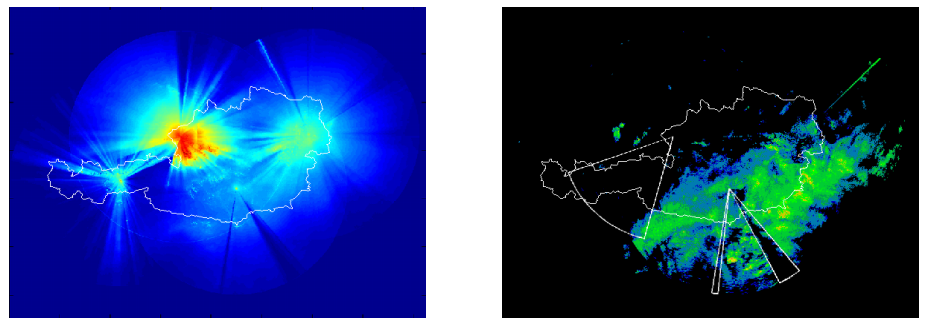Algorithm Fixes Weather Radar Images Distorted by Wi-Fi
Weather radar plays a crucial role in air traffic control where controllers are constantly evaluating the possibility of storms, windshear, the danger of icing, and so on. To route aircraft as safely as possible, these weather radar images need to be as clear and accurate as possible.

Unfortunately, that’s not always the case. Weather radar images are often distorted by reflections, shadows, ground clutter, atmospheric turbulence, and many other sources of noise. And a particular problem is in mountainous areas, where it’s difficult to get complete radar coverage of the region.
One of these places is the airspace above Austria, a country in central Europe that is dominated by the Alps. Austria has four fixed weather radar systems, each with an operating distance of 225 km. In theory, that should provide complete coverage of this relatively small country. But in practice, the images display numerous shadows, false echoes, and other noise that increase the problems of interpretation.
Now Harald Ganster at Joanneum Research in Graz, Austria, and a few pals say they’ve come up with a solution. These guys have been working on an image analysis algorithm that automatically identifies various kinds of interference and removes it, pixel by pixel.
At the same time, it looks for shadows in the images where the terrain prevents weather-related echoes from reaching the receiver. It then fills in the gaps.
Weather radar images are more prone to distortion than you might imagine. Ganster and co say that of 8,928 images taken by one radar station in May 2011, 2,713 showed interference from five GHz Wi-Fi systems (a relatively new and well-known problem in meteorological circles). That’s over 30 percent of the images.
“Improvement of weather radar images is essential for an accurate prediction of weather phenomena and atmospheric conditions, which is furthermore an essential factor in the work process of air traffic controllers,” say Ganster and co.
Their approach relies on the special characteristics of different kinds of interference. For example, Wi-Fi appears in radar images as a straight line, as in the top right hand corner of the right hand picture above.
Ganster and co have developed an algorithm that maps all straight lines in an image into vertical ones, which are then easy to remove. Since there are no naturally occurring structures that are straight, at least not on weather radar images, this removes Wi-Fi interference with high accuracy.
At the same time, the team looked at the distribution of rain in a year’s worth of pictures (left image above). This clearly reveals radar shadows where the devices receive no data.
To combat this, they have developed an algorithm that fills in the gaps with meteorologically reasonable values. They do this by looking at images of the same region taken from space by the Meteosat Second Generation satellite.
These images do not provide the same resolution or detail as the weather radar. But they do show whether there are large variations in the weather in the shadowed regions. The algorithm then fills in the gaps by ensuring the difference between the radar image and the satellite image is minimized.
Ganster and co say their new system “is able to improve weather radar images in a meteorologically reasonable manner.”
It is currently being evaluated by Austrian air traffic control where controllers can look at “before” and “after” images and give feedback on how useful the modified images are.
This should allow the controllers to improve their forecasts in near real time. “The improved forecasts will in turn have significant effects on safety in aviation,” say Ganster and co.
Not bad!
Ref: arxiv.org/abs/1404.6351: Improving Weather Radar By Fusion And Classification
Keep Reading
Most Popular
Large language models can do jaw-dropping things. But nobody knows exactly why.
And that's a problem. Figuring it out is one of the biggest scientific puzzles of our time and a crucial step towards controlling more powerful future models.
How scientists traced a mysterious covid case back to six toilets
When wastewater surveillance turns into a hunt for a single infected individual, the ethics get tricky.
The problem with plug-in hybrids? Their drivers.
Plug-in hybrids are often sold as a transition to EVs, but new data from Europe shows we’re still underestimating the emissions they produce.
Google DeepMind’s new generative model makes Super Mario–like games from scratch
Genie learns how to control games by watching hours and hours of video. It could help train next-gen robots too.
Stay connected
Get the latest updates from
MIT Technology Review
Discover special offers, top stories, upcoming events, and more.